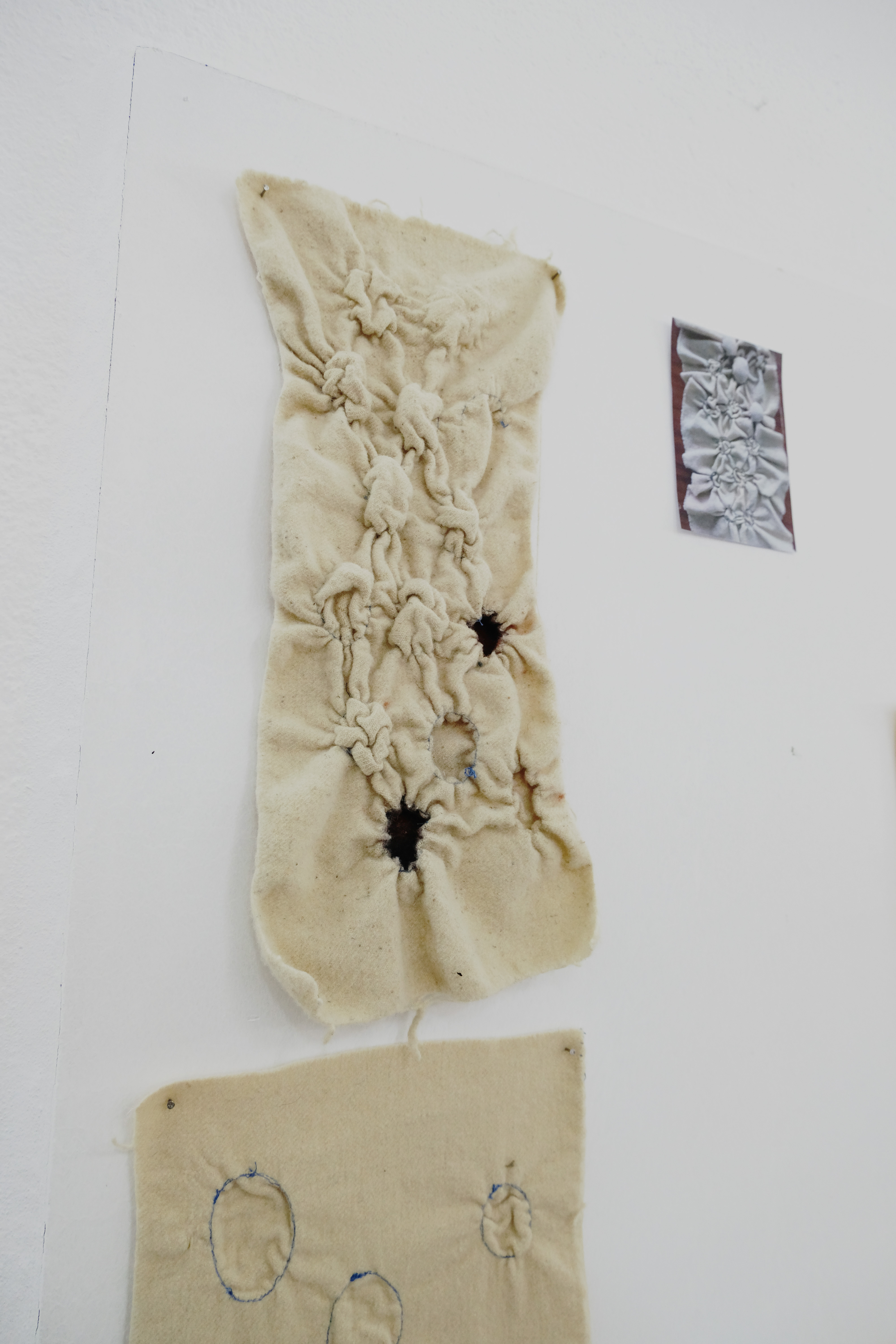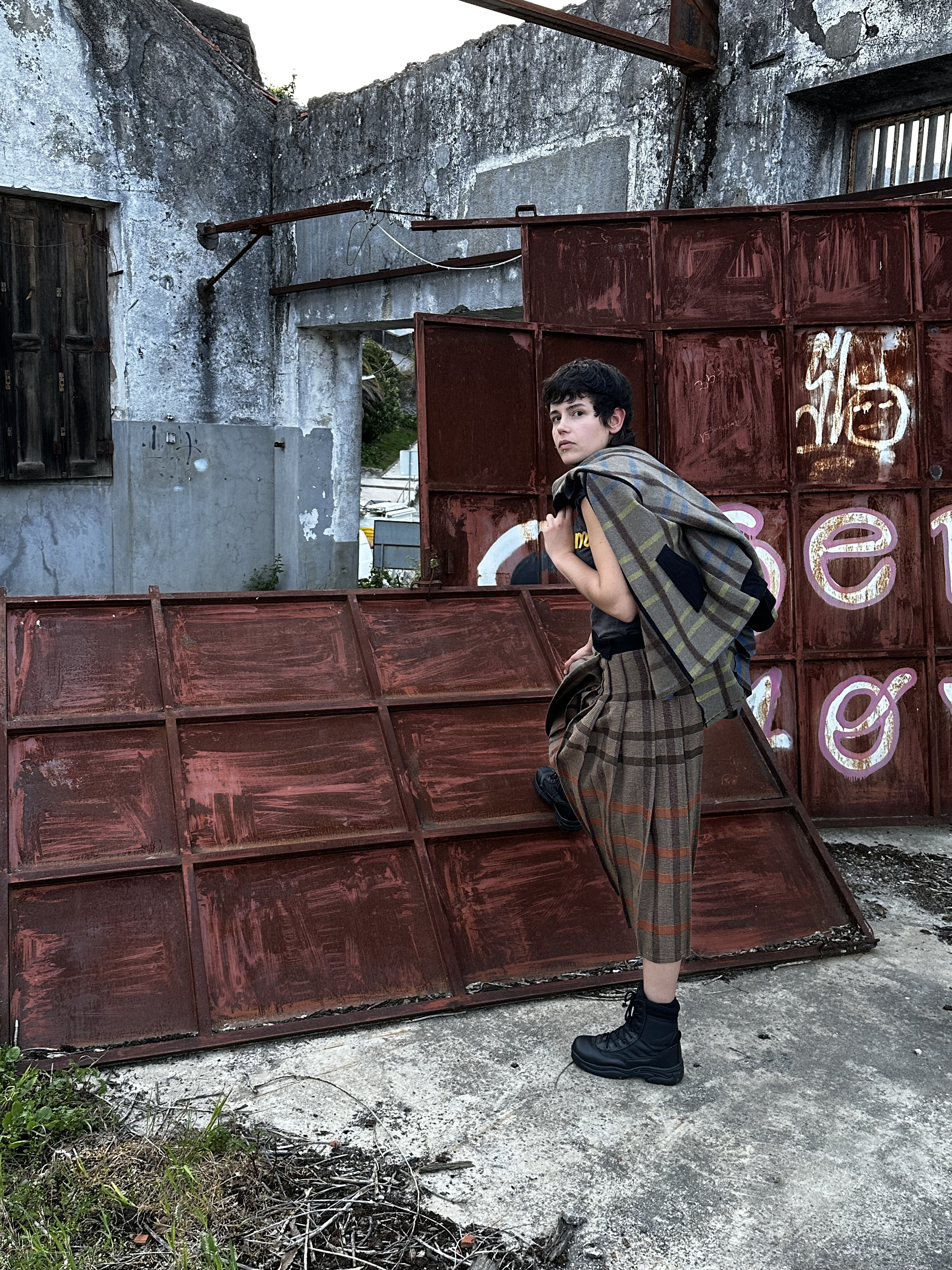Trienal Design Covilhã Residency -
Residencies in Factories (2025)






Project title: Batano Beat
The project “Batano Beat” at A Transformadora is based on trial-and-error methods which has resulted in broadening the spectre of industrial felting possibilities and its limitations.
A Transformadora specializes in various types of industrial finishings such as felting, dyeing, shearing, and decatising. The famous burel fabric, applied both in interior and fashion design, is felted here, which gives it such qualities as durability, warmth and weather resistance. The machine responsible for this kind of mechanical felting is batano. It is half-manually operated and requires a lot of experience, considerable skills, and intuition. That alone challenges once more the artificial divide between craft and industry!
During this residency, two ideas have been tested, one of which is 3-D felting. The second idea focuses on combining different kinds of fibres in pre-felted woven fabrics in order to create relief-like, uneven surfaces, in contrast to the very smooth burel fabrics.
For this project, a fabric was woven at the Burel factory and finished at A Transformadora. The inspiration for the color palette and the pattern comes from the fabric swatches collected by René Ferdinand Delimbeuf available at the Wool Museum archive and the image research on my daily route from the residency to the factory. The comfort and functionality were inspired by the shepherd's outfit, traditional in the region of Serra da Estrela.
Thank you for your support and invaluable work:
Isabel Dias da Costa, Ricardo Gil Pereira, Prof. Rita Salvado, Adozinda Maria Farias, Susana Antunes, Rui Paiva, Rui Fazendeiro, Rui Pontifice, Carmo Rodrigues, Fernando Vicente, Paulo Cardina, Ana Luzia Guerreiro, Luis Morgado, Jose Luis Abrantes, Dina Almeida, Paula Felix, Carlos Farias, Andreia Félix, Helena Correia, Rogério Cunha, Thais Marçon, Amélia Gomes, Laura Nogueira.
model: Laura Nogueira
Artist in Residence at DOCK 20 - Kunstraum und Sammlung Hollenstein, Lustenau(2020)
When crude oil and embroidery meet. When crude oil and embroidery meet. When crude oil and embroidery meet. When crude oil and embroidery meet.



exhibition photos: Miro Kuzmanovic
This six-week residency at DOCK20 - Kunstraum und Sammlung Hollenstein (Lustenau, Austria) is based on artistic research that explores the notion of African Lace in the context of the local machine embroidery indusrty. The project resulted in the textile piece “the head” and in a two-channel video work based on found footage and the archive material kindly provided by the S-MAK and DOCK20 gallery in Lustenau. “The head” was acquired by vorarlberg museum.
the head is a reflection on the notion of African lace as ethnologically misleading, incomplete in its glamorous overshadowing ambiguity and complexity of the processes involved in its formation. It is textile embodiment of the entanglement between the Nigerian postcolonial oil class’ desire for self-empowerment with Austrian export market ambitions. The head refers to one of the bronze Heads of Ife - the cultural and commercial center of the Yoruba people. Unearthed in Nigeria at the beginning of 20th century, it is still kept in the British Museum. It has become a symbol of beauty, pride and controversy due to the denial of its creators’ origin. The head (ori) has, in general, a sacred meaning in the Yoruba culture.
The scarification on the head is hand-embroidered. The head piece, placed on the head, is inspired by a traditional hat of the Vorarlberg region, the so-called Radhaube. Originally hand-embroidered, here it is locally machine-embroidered.
Expressing my deepest gratitude to Anne Zühlke, Claudia Voigt, and Daniela Fetz.
This six-week residency at DOCK20 - Kunstraum und Sammlung Hollenstein (Lustenau, Austria) is based on artistic research that explores the notion of African Lace in the context of the local machine embroidery indusrty. The project resulted in the textile piece “the head” and in a two-channel video work based on found footage and the archive material kindly provided by the S-MAK and DOCK20 gallery in Lustenau. “The head” was acquired by vorarlberg museum.
the head is a reflection on the notion of African lace as ethnologically misleading, incomplete in its glamorous overshadowing ambiguity and complexity of the processes involved in its formation. It is textile embodiment of the entanglement between the Nigerian postcolonial oil class’ desire for self-empowerment with Austrian export market ambitions. The head refers to one of the bronze Heads of Ife - the cultural and commercial center of the Yoruba people. Unearthed in Nigeria at the beginning of 20th century, it is still kept in the British Museum. It has become a symbol of beauty, pride and controversy due to the denial of its creators’ origin. The head (ori) has, in general, a sacred meaning in the Yoruba culture.
The scarification on the head is hand-embroidered. The head piece, placed on the head, is inspired by a traditional hat of the Vorarlberg region, the so-called Radhaube. Originally hand-embroidered, here it is locally machine-embroidered.
Expressing my deepest gratitude to Anne Zühlke, Claudia Voigt, and Daniela Fetz.